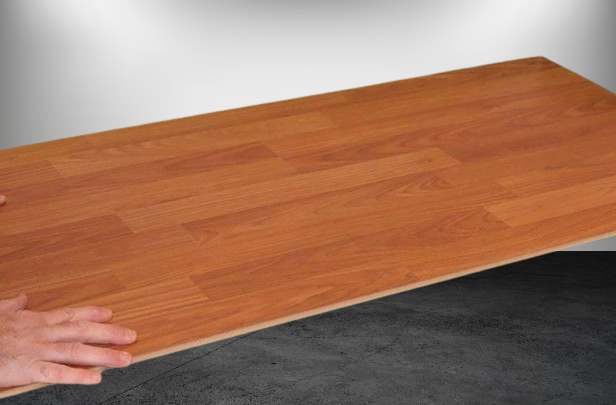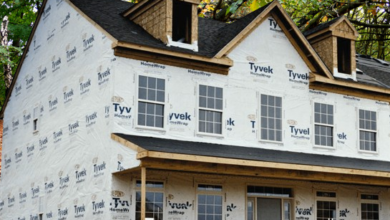Laminate Flooring Over Foam Board

Laminate flooring is a practical and reasonably priced flooring choice. They work well in kitchens, living rooms, and even bedrooms.
Particleboard wood is the base of laminate floors, and an image layer is attached to it. These days, the deep embossing and improved images on these floors give them a sharper, more superior appearance than most floor finishes.
Laminate floors can be installed on many different types of substrates, but can they be installed over foam boards? That’s what this article’s discussion will center around.
Is Laying Laminate Flooring Over Foam Board A Wise Idea?
You should not be putting laminate flooring over foam board at all. Any building project will frequently use foam boards as insulation.
Building codes state that insulation is not a permitted structural component. As such, you are creating a recipe for disaster when you lay laminate flooring over foam board.
It goes beyond laminate flooring. Every kind of flooring needs to be installed over a subfloor that is structurally sound. Foam board is by no means regarded as a subfloor with sound structural integrity.
The laminate floor will fail and require expensive and time-consuming repairs if it is placed directly on top of the foam board.
Why Would Someone Want to Lay a Laminate Floor Upon a Foam Board?
Before delving much further into this project, it is important to understand the potential motivations behind installing a laminate floor over foam board. There are just two reasons for this.
- 1. You Have An Interest in Laminate Floors
There are several explanations for why laminate flooring is popular. It looks fantastic. These days, thousands of images are available for selection, and custom graphics are also an option.
The best thing about laminate floors is that they are a cheap flooring material and they are incredibly easy to clean. Thus, it’s the ideal option if you’re building a floor on a tight budget.
- 2. You would like to heat the subfloor.
Not everyone enjoys the luxury of residing in a place with pleasant climate. Freezing subfloors are a problem for those who live in colder climates, which can be quite inconvenient.
One of the best materials for insulation is foam board. By preventing the cold temperatures from the concrete slab from rising to the surface of your floor, it can significantly raise its temperature if applied to the floor.
Any of these good reasons could make someone want to lay laminate flooring over foam board. However, what dangers come with taking on such a project? Let’s investigate!
Issues Regarding Laminate Flooring Installed Over Foam Board
Here are some of the dangers associated with installing a laminate floor over foam board to demonstrate why it’s not a good idea:
- The surface will feel excessively bouncy or spongy.
Because laminate floors are relatively thin, the subfloor below greatly affects their structural integrity. Your laminate floor will always feel like it’s on springs if there is foam board underneath.
- There won’t be enough support for the laminate floor to support weight or load.
Only when foam board is dispersed over a fair area can it support a sizable weight.
But the structure will be weakened if a 500-pound person steps on a laminate floor that has foam board underneath. This explains why walking on a laminate floor that is layered over foam board feels spongy.
Laminate flooring should never be installed directly over foam board because of these two issues. The likelihood of failure is simply too great.
Is it possible to avoid these risks and correctly install laminate flooring over foam board?
There are a lot of gaps in the DIY construction world. As a result, you can never declare a project to be impossible.
In the scenario above, there exists a technique that can be employed to mitigate the aforementioned risks.
Before installing a laminate floor, the foam board must be positioned between two layers of OSB. The goal is to install insulation between the laminate floorboards while still providing a structurally sound surface for them.
The following is how it should be installed in this case:
- i. Start by adding an OSB layer.
- ii. Continue putting in your foam board.
- iii. Add another layer of OSB on top of it, ideally 3/8″ thick.
- iv. Complete installing your laminate flooring
The floor won’t feel springy when two layers of OSB are sandwiched together because the structure has been strengthened. To make the structure much stronger, I suggest using fasteners to hold the system together.
This method has been successfully used by many who have tried it. But there are a few disadvantages.
For example, the two OSB layers and the foam board will make the floor thicker. There may be an impact on door movement. Furthermore, the foam board will eventually compress, but by then, it will have provided years of warmth for your floor.
Can I Use Rigid Foam Boards With High Densities and Laminate Flooring?
Can rigid foam board be used in place of regular foam board since the latter isn’t structurally sound? Under the laminate floor, none of the insulation materials—including rigid foam board—will perform well.
This is due to the fact that excessive weight can cause even stiff foam board to give way. It might hold out a little longer than an ordinary foam board, but it will eventually break.
It won’t help much, therefore, to swap out a standard foam board for a high-density one. All you’ll be doing is postponing the inevitable.
What is the lifespan of a laminate floor over foam board?
If, instead of employing the OSB method I previously described to you, you lay the laminate floor directly on top of the foam board.
It’s just a matter of time until the laminate floor fails. It may take a few weeks or months for this to occur, depending on the area and volume of traffic.
In high-traffic areas like living rooms, the foam board will deteriorate rapidly. And the laminate floor will break as a result of that.
The initial installation phase will have saved you a lot of money, but the repairs will be more expensive and time-consuming.
Do Manufacturers of Laminate Flooring Approve Its Use Instead of Foam Board?
Manufacturers will say anything to get you to purchase their goods. Thus, it shouldn’t come as a surprise if they advise installing laminate rather than foam board.
What matters more to you, though, is if they provide a warranty for installing laminate over foam board. As a result, they will cover any losses or damages you sustain.
Is A Moisture Barrier Necessary When Installing Laminate Flooring Over Foam Board?
A moisture barrier is necessary for laminate floors even if you plan to forego installing a foam board. The majority of them have a moisture barrier, which is good news. Therefore, installing one separately is not necessary. But you should always make sure beforehand.
Exist Any Other Options Besides Using Foam Board?
Your floors can get warm from sources other than foam board. Laminate flooring can provide some insulation from concrete on its own if a cold floor is your main worry.
Additionally, you could buy a carpet. Put rugs in places where people walk a lot to get rid of cold floors. Rugs also give your house a beautiful touch.
Setting up a floor heater is an additional choice that is worthwhile. Your laminate floor can be kept warm all the time with a radiant floor heating system.
Additionally, you can look into cove or space heaters. There are lots of options available to warm your floors.

